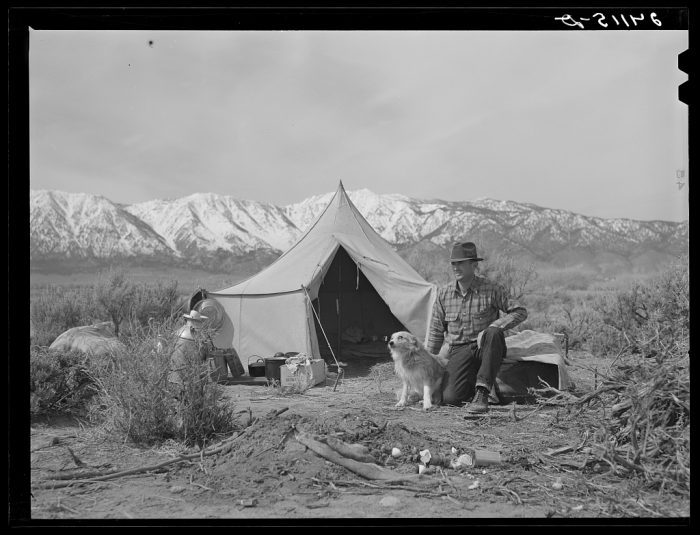The Moab, Utah Canyon Country Zephyr is published in one of those places we’re dying to visit because of the important Basque presence there, in a state we’ve talked about very often.
We found an article on their website about the history of Basque sheepherders in the US, which we knew was an immediate “must-include” on our blog, where we’ve thoroughly covered that part of our diaspora. In addition to providing us with a deep and very well illustrated tour of the Basque journey in the world, it also gives us the bonus of helping those who are most interested in these topics dig even deeper.
This article comes to us at the best time. We just covered the closure of the Noriega Hotel, an icon of the Basque presence out west for almost a century. Indeed that restaurant was even mentioned in this article, almost as a premonition:
Very little survives of the era of Basques in the American West. The fading stencil of the word “BASQUE” lingers on crumbling brick facades in Nevada. At scattered addresses throughout Idaho and California, a few curiously named hotels—the Pyrenees, the Noriega, Des Alpes—don’t seem to fit among the region’s otherwise identifiable ethnic blend of Cowboy White/Hispanic/Native American. All over the West, little artifacts of this strange “other” culture abound, but they’re easily missed.
So, we’ve come to a juncture, with that feeling of the loss and the end of an era on the one hand, with the Basque sheepherders and their flock, and the rising of a new era for the Basques in the US. Just last month, Vince J. Juaristi discussed this in an article we brought you:
The results are vivid among the 57,000 Basque in America today. According to the last census, more than 75% of Basque age 25 years or older have some level of college education compared to only 58% of Americans overall. They are 31% more likely to hold jobs in management, business, science or the arts. Their median household income is $70,159 compared to the U.S. median of $52,176. Their poverty rate is half the national average, and they are more likely to own their own home. When they do, the home is 48% more valuable than the average American home.
To that, we have to add the blog entry David Bieter wrote after the last Jaialdi, five years ago, which he gave a very good title to: “Now Might Be the Best Time Ever to Be a Basque“. He was talking about all Basques as a whole, but also about the Basques in the States, undoubtedly thinking about what he’d be writing in his follow-up entry five years later.
We want to join in, wishing our best to that Basque community, hoping it always moves forward, following the advice given by Lehendakari Aguirre to those who had to take refuge abroad when the Francoist insurgents were victorious: “in your adopted homeland, be, among all citizens, the best”, continuing that mark of identity and behavior that Basque emigrants have overwhelmingly had for centuries. But we also hope that, in addition to that, it also maintains its roots and history as a People, its mark on its adopted homeland, alive and strong.
Because that mark the Basque sheepherders had was very important, as the Canyon Country Zephyr tells us.
We’ll leave you with Tonya Audyn Stiles‘ article and also the references included in it, such as the “Sierra Basques” article written by Jennifer K. Crittenden, or the other references covering this topic. We think it’s important and we’d like to have all the old entries well indexed.
Canyon Country Zephyr – 1/12/2019 – USA
The Other Lonely Rangers: The Forgotten Lives of America’s Basque Sheepherders


It was the trial of the year in Moab, Utah. The courtroom was packed full by Ten in the morning, November 18th of 1921. Tensions had been brewing a long time between the cattlemen of Southeast Utah and the encroaching sheep herders from the south. The previous February, one sheepherder had crossed the line. Or so the defense attorney argued before the assembled crowd.
(Follow) (Automatic translation)
Mammoth Letters -2016 – USA
Sierra Basques
The movie Thunder in the Sun recounts the adventures of a French Basque pioneer family as it makes its way west, narrowly escaping an Indian attack at Whitney Portal. The movie highly amused real Basques with its depiction of a jai alai game baton being used as a weapon and of characters screeching at each other, as though that’s how Basques talk. The movie was accurate however in positing Basques in the Eastern Sierra. And if you pay attention, you can still see the marks they literally left behind on the landscape.
(Follow) (Automatic translation)
Basque Sheep Herders of the American West A Photographic Documentary (ver)
HISTORY OF EUZKO – ETXEA OF NEW YORK.” New York Basque Club. (ver)
Sobre Charlie Glass and Felix Jesui:“It Happened in Utah: Stories of Events and People that Shaped Beehive State History” by Tom Wharton. Rowman & Littlefield, Dec 21, 2018 (ver)
Last Updated on Apr 16, 2023 by About Basque Country




























